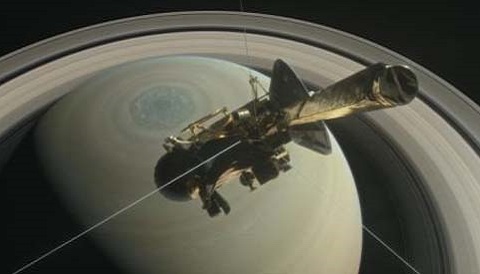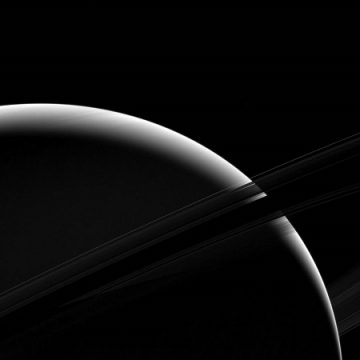NASA's Cassini mission nears its final act — the spacecraft will enter the first of its Grand Finale Orbits later this month.

NASA / JPL-Caltech
Get set for a wild ride.
After almost 20 years in space, Cassini will enter the “beginning of the end.” It starts in late April with the first of a series of Grand Finale Orbits. Cassini promises to deliver amazing science as well as never-before-seen views of the ringed planet right up until the very end.
"I feel a little sad that Cassini will end," said Jim Green (NASA) during a press conference, "but I'm also quite optimistic that we're going to discover some new and really exciting science as we enter a region that we've never probed before."
The action starts on April 22nd with a final Titan flyby, which sets up Cassini for its 22 final orbits around Saturn. This flyby is also the closest for Cassini since 2010, as the spacecraft will skim just 615 miles (990 km) above the shrouded moon. Then, on April 26, Cassini will take the plunge, diving through the 1,500-mile-wide gap between the innermost D-ring and Saturn's cloudtops at 70,000 mph. The spacecraft will continue to make similar passes once a week for the mission's final duration. These Grand Finale orbits will take Cassini from a periapsis (closest approach) of 39,000 miles from Saturn's center out to an apoapsis of 87,000 miles, past the outermost edge of the F-ring.
Even if Cassini gets pummeled with ring debris during these daring final passes, the ballistic trajectory assures its final disposal. Engineers will use Cassini's large main High Gain Antenna as a shield on each pass through the ring plane.
"The planned conclusion for Cassini's journey was far and away the preferred choice for the mission's scientists," says Linda Spilker (NASA-JPL) in a recent press release. "Cassini will make some of its most extraordinary observations at the end of its long life."
Scientists at NASA's Jet Propulsion Laboratory previewed Cassini's Grand Finale series of orbits on Tuesday, showcasing just what to expect from the beginning of Cassini's end.
In some ways, the final orbits mark a whole new mission, taking Cassini to new territory. Scientists aim to get a lot of data out of these final orbits:
- Cassini will map Saturn's magnetic and gravitational fields in order to probe the planet's internal structure and refine our understanding of its internal rotation
- Scientists will analyze the mass and structure of Saturn's rings using a series of radio occultations on each successive pass
- The spacecraft will sample the charged particles funneled by Saturn's magnetic field from the rings into the planet's atmosphere
Expect some dazzling images of Saturnian cloudtops as well, as the spacecraft gets up close and personal to the planet like never before.

NASA / JPL-Caltech
Over the past few months, the Ring Grazing Orbits have given us an amazing set of views. We've also had some great recent views of the enigmatic “polar hexagon,” as well as moon close-ups of ravioli-shaped Pan and Daphnis as it braids the Keeler Gap.
Expect close flybys of the tiny moonlets Epimetheus, Pandora, and Atlas on April 5th, with more to come.
Space Science Workhorse
Launched on October 15, 1997, atop a Titan IVB rocket from Cape Canaveral Air Force Station, Cassini made a gravity-assist flyby past Venus (1998 and 1999), Earth (1999), and Jupiter (2000) before arriving in orbit around Saturn on July 1, 2004. Cassini is the fourth mission to visit Saturn, a legacy that started with the Pioneer 11 flyby in 1979 and continued with Voyager 1 (1980) and Voyager 2 (1981).
Unlike its predecessors, though, Cassini entered orbit around Saturn, enabling scientists to study longterm changes on the planet. Cassini also delivered the European Space Agency's Huygens lander to Titan, which made the most distant landing on another world on January 14, 2005. Cassini gave us close-up views of worlds only glimpsed during previous flybys, revealed seven new moons orbiting Saturn, ice geyser plumes on Enceladus, methane lakes on Titan, spokes in the rings of Saturn, and much more.
But Cassini and the team of scientists behind it have a poetic side, as well, revealing a glorious back-lit Saturn as the spacecraft passed through the planet's shadow. Then, on July 19, 2013, researchers turned Cassini's cameras back on its world of origin: It imaged Earth just beyond Saturn's limb during The Day the Earth Smiled campaign.

NASA / JPL / Caltech / Space Science Institute
Now, the end is near: September 15, 2017, at 10:44 UT is when Cassini will plunge into Saturn's dense atmosphere.
It'll be sad to see Cassini go, but the maneuver is a necessary precaution to avoid any future contamination of Enceladus or Titan, worlds which could harbor life. Cassini will beam back its final images just a few hours prior to destruction, and its mass spectrometer will take data during its fiery atmospheric plunge. Signal travel time at the end will be 83 minutes.
"It's going to be hard to say goodbye to this plucky spacecraft that delivered some amazing science," says Spilker. Researchers (and science writers, too!) have grown up with the Cassini mission.
When will we return? Well, while there's been talk of dedicated missions to Titan or Enceladus, these are at best a decade or more away. Solar power is too feeble to power a spacecraft in the outer solar system, and the U.S. Department of Energy only recently announced a restart of plutonium production for NASA in 2013.
Enjoy these final few months, as Cassini gives us some unparalleled views of the original Ringed Planet.
 2
2









Comments
Filipe-Machado
April 7, 2017 at 10:43 pm
Instead of destrying a good tool they could send Cassini outside solar system like Voyager and Pioneerand use its camers to scan solar system from above and help search for Planet 9.
You must be logged in to post a comment.
Marc Dubbeldam
July 5, 2017 at 8:52 am
No they can't: to escape Saturn's gravitational pull requires vast amounts of fuel, which Cassini does not have.
You must be logged in to post a comment.
You must be logged in to post a comment.